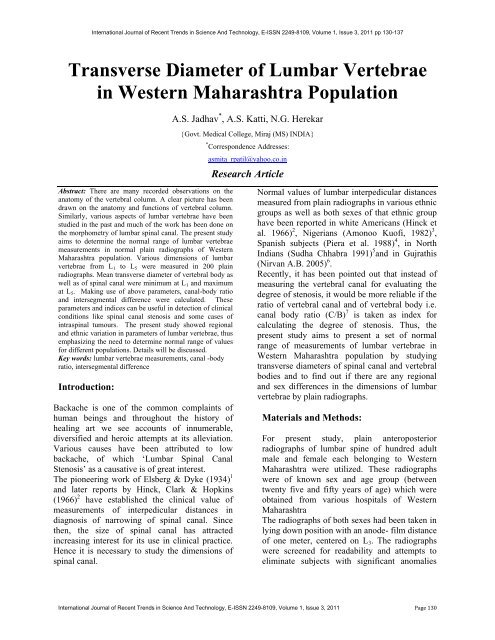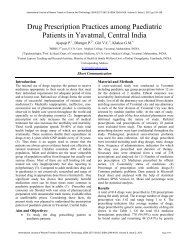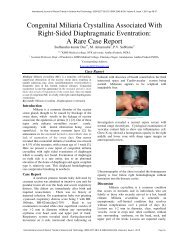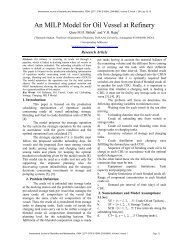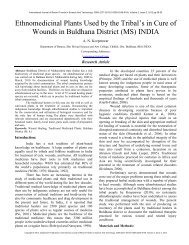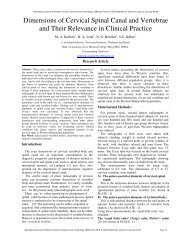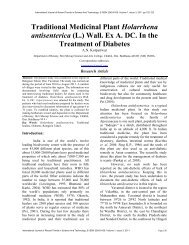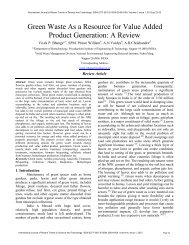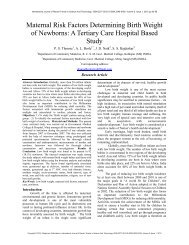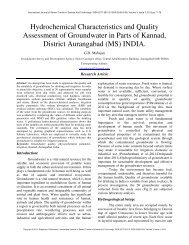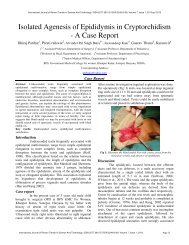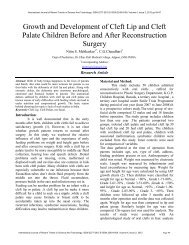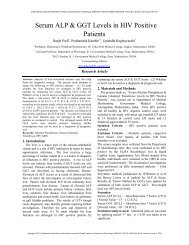Transverse Diameter of Lumbar Vertebrae in Western ... - Statperson
Transverse Diameter of Lumbar Vertebrae in Western ... - Statperson
Transverse Diameter of Lumbar Vertebrae in Western ... - Statperson
Create successful ePaper yourself
Turn your PDF publications into a flip-book with our unique Google optimized e-Paper software.
International Journal <strong>of</strong> Recent Trends <strong>in</strong> Science And Technology, E-ISSN 2249-8109, Volume 1, Issue 3, 2011 pp 130-137<br />
<strong>Transverse</strong> <strong>Diameter</strong> <strong>of</strong> <strong>Lumbar</strong> <strong>Vertebrae</strong><br />
<strong>in</strong> <strong>Western</strong> Maharashtra Population<br />
A.S. Jadhav * , A.S. Katti, N.G. Herekar<br />
{Govt. Medical College, Miraj (MS) INDIA}<br />
* Correspondence Addresses:<br />
asmita_rpatil@yahoo.co.<strong>in</strong><br />
Research Article<br />
Abstract: There are many recorded observations on the<br />
anatomy <strong>of</strong> the vertebral column. A clear picture has been<br />
drawn on the anatomy and functions <strong>of</strong> vertebral column.<br />
Similarly, various aspects <strong>of</strong> lumbar vertebrae have been<br />
studied <strong>in</strong> the past and much <strong>of</strong> the work has been done on<br />
the morphometry <strong>of</strong> lumbar sp<strong>in</strong>al canal. The present study<br />
aims to determ<strong>in</strong>e the normal range <strong>of</strong> lumbar vertebrae<br />
measurements <strong>in</strong> normal pla<strong>in</strong> radiographs <strong>of</strong> <strong>Western</strong><br />
Maharashtra population. Various dimensions <strong>of</strong> lumbar<br />
vertebrae from L 1 to L 5 were measured <strong>in</strong> 200 pla<strong>in</strong><br />
radiographs. Mean transverse diameter <strong>of</strong> vertebral body as<br />
well as <strong>of</strong> sp<strong>in</strong>al canal were m<strong>in</strong>imum at L 1 and maximum<br />
at L 5 . Mak<strong>in</strong>g use <strong>of</strong> above parameters, canal-body ratio<br />
and <strong>in</strong>tersegmental difference were calculated. These<br />
parameters and <strong>in</strong>dices can be useful <strong>in</strong> detection <strong>of</strong> cl<strong>in</strong>ical<br />
conditions like sp<strong>in</strong>al canal stenosis and some cases <strong>of</strong><br />
<strong>in</strong>trasp<strong>in</strong>al tumours. The present study showed regional<br />
and ethnic variation <strong>in</strong> parameters <strong>of</strong> lumbar vertebrae, thus<br />
emphasiz<strong>in</strong>g the need to determ<strong>in</strong>e normal range <strong>of</strong> values<br />
for different populations. Details will be discussed.<br />
Key words: lumbar vertebrae measurements, canal -body<br />
ratio, <strong>in</strong>tersegmental difference<br />
Introduction:<br />
Backache is one <strong>of</strong> the common compla<strong>in</strong>ts <strong>of</strong><br />
human be<strong>in</strong>gs and throughout the history <strong>of</strong><br />
heal<strong>in</strong>g art we see accounts <strong>of</strong> <strong>in</strong>numerable,<br />
diversified and heroic attempts at its alleviation.<br />
Various causes have been attributed to low<br />
backache, <strong>of</strong> which ‘<strong>Lumbar</strong> Sp<strong>in</strong>al Canal<br />
Stenosis’ as a causative is <strong>of</strong> great <strong>in</strong>terest.<br />
The pioneer<strong>in</strong>g work <strong>of</strong> Elsberg & Dyke (1934) 1<br />
and later reports by H<strong>in</strong>ck, Clark & Hopk<strong>in</strong>s<br />
(1966) 2 have established the cl<strong>in</strong>ical value <strong>of</strong><br />
measurements <strong>of</strong> <strong>in</strong>terpedicular distances <strong>in</strong><br />
diagnosis <strong>of</strong> narrow<strong>in</strong>g <strong>of</strong> sp<strong>in</strong>al canal. S<strong>in</strong>ce<br />
then, the size <strong>of</strong> sp<strong>in</strong>al canal has attracted<br />
<strong>in</strong>creas<strong>in</strong>g <strong>in</strong>terest for its use <strong>in</strong> cl<strong>in</strong>ical practice.<br />
Hence it is necessary to study the dimensions <strong>of</strong><br />
sp<strong>in</strong>al canal.<br />
Normal values <strong>of</strong> lumbar <strong>in</strong>terpedicular distances<br />
measured from pla<strong>in</strong> radiographs <strong>in</strong> various ethnic<br />
groups as well as both sexes <strong>of</strong> that ethnic group<br />
have been reported <strong>in</strong> white Americans (H<strong>in</strong>ck et<br />
al. 1966) 2 , Nigerians (Amonoo Ku<strong>of</strong>i, 1982) 3 ,<br />
Spanish subjects (Piera et al. 1988) 4 , <strong>in</strong> North<br />
Indians (Sudha Chhabra 1991) 5 and <strong>in</strong> Gujrathis<br />
(Nirvan A.B. 2005) 6 .<br />
Recently, it has been po<strong>in</strong>ted out that <strong>in</strong>stead <strong>of</strong><br />
measur<strong>in</strong>g the vertebral canal for evaluat<strong>in</strong>g the<br />
degree <strong>of</strong> stenosis, it would be more reliable if the<br />
ratio <strong>of</strong> vertebral canal and <strong>of</strong> vertebral body i.e.<br />
canal body ratio (C/B) 7 is taken as <strong>in</strong>dex for<br />
calculat<strong>in</strong>g the degree <strong>of</strong> stenosis. Thus, the<br />
present study aims to present a set <strong>of</strong> normal<br />
range <strong>of</strong> measurements <strong>of</strong> lumbar vertebrae <strong>in</strong><br />
<strong>Western</strong> Maharashtra population by study<strong>in</strong>g<br />
transverse diameters <strong>of</strong> sp<strong>in</strong>al canal and vertebral<br />
bodies and to f<strong>in</strong>d out if there are any regional<br />
and sex differences <strong>in</strong> the dimensions <strong>of</strong> lumbar<br />
vertebrae by pla<strong>in</strong> radiographs.<br />
Materials and Methods:<br />
For present study, pla<strong>in</strong> anteroposterior<br />
radiographs <strong>of</strong> lumbar sp<strong>in</strong>e <strong>of</strong> hundred adult<br />
male and female each belong<strong>in</strong>g to <strong>Western</strong><br />
Maharashtra were utilized. These radiographs<br />
were <strong>of</strong> known sex and age group (between<br />
twenty five and fifty years <strong>of</strong> age) which were<br />
obta<strong>in</strong>ed from various hospitals <strong>of</strong> <strong>Western</strong><br />
Maharashtra<br />
The radiographs <strong>of</strong> both sexes had been taken <strong>in</strong><br />
ly<strong>in</strong>g down position with an anode- film distance<br />
<strong>of</strong> one meter, centered on L 3 . The radiographs<br />
were screened for readability and attempts to<br />
elim<strong>in</strong>ate subjects with significant anomalies<br />
International Journal <strong>of</strong> Recent Trends <strong>in</strong> Science And Technology, E-ISSN 2249-8109, Volume 1, Issue 3, 2011 Page 130
A.S. Jadhav, A.S. Katti, N.G. Herekar<br />
and other problems likely to <strong>in</strong>fluence growth<br />
and development.<br />
The measurements were made by<br />
us<strong>in</strong>g vernier calliper and were recorded to the<br />
nearest tenth <strong>of</strong> a millimeter. The dimensions <strong>of</strong><br />
all vertebrae were studied. The follow<strong>in</strong>g<br />
measurements were obta<strong>in</strong>ed from<br />
anteroposterior radiographs <strong>of</strong> lumbar sp<strong>in</strong>e<br />
(Photograph no.2).<br />
Photograph 1: Materials used for the present study<br />
A) The <strong>Transverse</strong> <strong>Diameter</strong> <strong>of</strong> Sp<strong>in</strong>al Canal<br />
/ Interpedicular Distance:<br />
This corresponds to transverse diameter <strong>of</strong><br />
sp<strong>in</strong>al canal and was obta<strong>in</strong>ed by measur<strong>in</strong>g<br />
the m<strong>in</strong>imum distance between the shadows<br />
<strong>of</strong> pedicles <strong>of</strong> same vertebra.<br />
B) The <strong>Transverse</strong> <strong>Diameter</strong> <strong>of</strong> Vertebral<br />
Body:<br />
This was taken as the midvertebral distance<br />
between the po<strong>in</strong>ts on lateral borders <strong>of</strong> vertebral<br />
body<br />
shadow.<br />
The follow<strong>in</strong>g <strong>in</strong>dices were obta<strong>in</strong>ed from above<br />
measurements, us<strong>in</strong>g the methods described by<br />
respective workers.<br />
1. The ‘ Canal Body ratio’ (C/B) 7 :<br />
This was calculated by consider<strong>in</strong>g<br />
transverse diameters <strong>of</strong> vertebral body and<br />
correspond<strong>in</strong>g sp<strong>in</strong>al canal as follows.<br />
C/B = <strong>Transverse</strong> <strong>Diameter</strong> <strong>of</strong> sp<strong>in</strong>al<br />
canal/ <strong>Transverse</strong> <strong>Diameter</strong> <strong>of</strong><br />
Vertebral Body<br />
2. Intersegmental Difference:<br />
This was calculated as the difference<br />
between the transverse diameters <strong>of</strong> sp<strong>in</strong>al canal<br />
<strong>of</strong><br />
the<br />
consecutive lumbar vertebra.<br />
The data collected was subjected to follow<strong>in</strong>g<br />
statistical tests.<br />
a) Mean<br />
b) Standard deviation<br />
c) Calculated range<br />
d) P- value.<br />
These dimensions <strong>of</strong> sp<strong>in</strong>al canal and vertebral<br />
body <strong>in</strong> males and females were evaluated for<br />
statistical significance. Also, us<strong>in</strong>g statistical<br />
tests, conditions like sp<strong>in</strong>al canal stenosis and<br />
<strong>in</strong>trasp<strong>in</strong>al tumor were evaluated and discussed.<br />
Copyright © 2011, <strong>Statperson</strong> Publications, International Journal <strong>of</strong> Recent Trends <strong>in</strong> Science And Technology, E-ISSN 2249-8109, Volume 1, Issue 3, 2011
International Journal <strong>of</strong> Recent Trends <strong>in</strong> Science And Technology, E-ISSN 2249-8109, Volume 1, Issue 3, 2011 pp 130-137<br />
Observation and Results:<br />
Range, mean and standard deviation <strong>of</strong><br />
the measurements <strong>of</strong> adult lumbar vertebrae<br />
were calculated. However when deal<strong>in</strong>g with<br />
normal distributions, maximum and m<strong>in</strong>imum<br />
limits can safely be calculated by add<strong>in</strong>g or<br />
subtract<strong>in</strong>g three standard deviation to the mean<br />
value <strong>of</strong> each measurement 8 . This gives the<br />
calculated range. Carefully measured <strong>in</strong>dividual<br />
dimensions fall<strong>in</strong>g outside the limits given<br />
should thus be viewed with suspicion <strong>of</strong><br />
pathology or anomaly. It must be borne <strong>in</strong> m<strong>in</strong>d<br />
on the other hand that, some abnormal figures<br />
may fall with<strong>in</strong> these limits.<br />
To know whether the difference<br />
observed between means <strong>of</strong> male and female is<br />
statistically significant; ‘P’ value was calculated<br />
by apply<strong>in</strong>g ‘Z’ test.<br />
Abbreviations used <strong>in</strong> follow<strong>in</strong>g tables are:<br />
1. S.D.:- Standard Deviation<br />
2. P: - Probability or the level <strong>of</strong> significance<br />
for difference between the two means.<br />
3. NS: - Non Significant<br />
Table I: Mean transverse diameters (mm) <strong>of</strong> sp<strong>in</strong>al canal <strong>in</strong> both the sexes<br />
Level Sex Group Range Mean<br />
Standard<br />
Deviation<br />
Male 20-29 24.38 1.69<br />
L 1 Female 16-27 21 2.44<br />
Male 21-30 25.25 1.86<br />
L 2 Female 16-28 21.81 2.69<br />
Male 22-33 27.08 2.08<br />
L 3 Female 18-30 23.56 2.78<br />
Male 23-35 29 2.28<br />
L 4 Female 20-32 25.44 2.70<br />
Male 27-39 32.42 2.29<br />
Female 23-36 28.63 2.79<br />
L 5<br />
Calculated<br />
P Value<br />
Range ± 3SD<br />
19.31-29.46<br />
13.69-28.31
A.S. Jadhav, A.S. Katti, N.G. Herekar<br />
Table II: Intersegmental Difference <strong>of</strong> the present study<br />
Level Male Female<br />
L 1 / L 2 0.86 0.81<br />
L 2 / L 3 1.84 1.74<br />
L 3 / L 4 1.92 1.89<br />
L 4 /L 5 3.42 3.19<br />
Table III: Mean transverse diameter (mm) <strong>of</strong> vertebral bodies <strong>in</strong> both sexes<br />
Standard<br />
Level Sex Group Range Mean<br />
Deviation<br />
L 1<br />
L 2<br />
L 3<br />
L 4<br />
L 5<br />
Male<br />
Female<br />
Male<br />
Female<br />
Male<br />
Female<br />
Male<br />
Female<br />
Male<br />
Female<br />
35-50<br />
28-44<br />
39-52<br />
30-46<br />
42-55<br />
33-48<br />
45-58<br />
35-51<br />
49-63<br />
37-55<br />
43.49<br />
37.26<br />
45.87<br />
39.26<br />
48.65<br />
41.81<br />
51.49<br />
44.41<br />
55.77<br />
47.36<br />
3.00<br />
3.30<br />
2.79<br />
3.30<br />
2.80<br />
3.39<br />
2.84<br />
3.41<br />
3.12<br />
3.79<br />
Calculated<br />
Range ±3SD<br />
P Value<br />
34.50-52.48<br />
27.36-47.16
International Journal <strong>of</strong> Recent Trends <strong>in</strong> Science And Technology, E-ISSN 2249-8109, Volume 1, Issue 3, 2011 pp 130-137<br />
available from previous studies they showed a<br />
significant difference at all lumbar level, thus<br />
necessitat<strong>in</strong>g separate normal ranges for male<br />
and female. Sometimes there is considerable<br />
overlapp<strong>in</strong>g <strong>of</strong> the ranges <strong>in</strong> male and female.<br />
This probably reflects the wide variations <strong>of</strong><br />
body sizes among male and female subjects.<br />
I. TRANSVERSE DIAMETER OF<br />
SPINAL CANAL:<br />
As per Table no.I, it is seen that, the mean<br />
transverse diameter <strong>of</strong> the sp<strong>in</strong>al canal goes on<br />
<strong>in</strong>creas<strong>in</strong>g from L 1 to L 5 .The transverse diameter<br />
is m<strong>in</strong>imum at L 1 and maximum at L 5 . This<br />
<strong>in</strong>creas<strong>in</strong>g trend <strong>of</strong> transverse diameter <strong>of</strong> sp<strong>in</strong>al<br />
canal is also seen <strong>in</strong> both the sexes however, the<br />
mean values are lower <strong>in</strong> females than males.<br />
This difference <strong>in</strong> males and females is<br />
statistically highly significant. Consider<strong>in</strong>g the<br />
calculated range, the limits <strong>of</strong> narrow<strong>in</strong>g <strong>of</strong><br />
sp<strong>in</strong>al canal or <strong>in</strong>trasp<strong>in</strong>al tumour can be<br />
suspected as described below. The values less<br />
than the lower limits <strong>of</strong> the calculated range are<br />
suggestive <strong>of</strong> sp<strong>in</strong>al canal stenosis. Similarly,<br />
the values more than the upper limits <strong>of</strong> the<br />
calculated range are suggestive <strong>of</strong> <strong>in</strong>trasp<strong>in</strong>al<br />
tumour (Table no. V). As per table no. VI, it is<br />
seen that, the mean <strong>in</strong>terpedicular distance <strong>in</strong><br />
males is highest <strong>in</strong> North Indians while it is<br />
lowest <strong>in</strong> Nigerians. The f<strong>in</strong>d<strong>in</strong>gs <strong>of</strong> the present<br />
study fall <strong>in</strong> between the two. As per the table<br />
no.VII, the mean values <strong>in</strong> females are<br />
comparable with those <strong>of</strong> Nigerians while the<br />
values when compared with North Indians, these<br />
are slightly less. It is probably because <strong>of</strong><br />
obvious difference <strong>in</strong> the built <strong>of</strong> the two.<br />
Table V: Shows the values (mm) suggestive <strong>of</strong> sp<strong>in</strong>al stenosis and <strong>in</strong>trasp<strong>in</strong>al tumour <strong>in</strong> the present<br />
study<br />
PRESENT STUDY<br />
Suggestive <strong>of</strong> Sp<strong>in</strong>al Stenosis Suggestive <strong>of</strong> Intrasp<strong>in</strong>al Tumour<br />
LEVEL MALES FEMALES MALES FEMALES<br />
L 1 < 19.31 < 13.69 >29.46 >28.31<br />
L 2 < 19.67 < 13.74 >30.82 >29.88<br />
L 3 < 20.84 < 15.23 >33.33 >31.89<br />
L 4 < 22.15 < 17.34 >35.85 >33.55<br />
L 5 < 25.55 < 20.27 >39.28 >36.99<br />
Table VI: Comparison <strong>of</strong> mean transverse diameter (mm) <strong>of</strong> the sp<strong>in</strong>al canal <strong>in</strong> males <strong>of</strong> previous<br />
studies and <strong>of</strong> the present study.<br />
TRANSVERSE DIAMETER OF SPINAL CANAL<br />
Authors<br />
n L 1 L 2 L 3 L 4 L 5<br />
H<strong>in</strong>ck et al. 1966 2<br />
(White Americans)<br />
59 25.9 26.5 26.8 27.6 30.7<br />
Amonoo Ku<strong>of</strong>i H.S. 1982 3<br />
(Nigerians)<br />
150 22.6 22.7 24.5 26 28.7<br />
Piera et al. 1988 4 (Spanish) 110 27.79 28.39 29.44 30.89 34.31<br />
Sudha Chhabra et al. 1991 5<br />
(North Indians)<br />
124 26.0 27.70 29.70 35.50 37.40<br />
Nirvan A.B. et al. 2005 6<br />
(Gujaratis)<br />
101 24.0 25.4 26.4 27.9 30.9<br />
Present study<br />
(<strong>Western</strong> Maharashtra)<br />
110 24.38 25.25 27.08 29 32.42<br />
International Journal <strong>of</strong> Recent Trends <strong>in</strong> Science And Technology, E-ISSN 2249-8109, Volume 1, Issue 3, 2011 Page 134
A.S. Jadhav, A.S. Katti, N.G. Herekar<br />
Table VII: Comparison <strong>of</strong> mean transverse diameter (mm) <strong>of</strong> the sp<strong>in</strong>al canal <strong>in</strong><br />
females <strong>of</strong> previous studies and <strong>of</strong> the present study.<br />
TRANSVERSE DIAMETER OF SPINAL CANAL<br />
Authors<br />
n L 1 L 2 L 3 L 4 L 5<br />
H<strong>in</strong>ck et al. 1966 2<br />
(White Americans)<br />
59 24.3 24.9 25.4 26.9 29.0<br />
Amonoo Ku<strong>of</strong>i H.S. 1982 3<br />
(Nigerians)<br />
140 21.30 22.50 23.70 25.40 28.40<br />
Piera et al. 1988 4 (Spanish) 105 25.66 26.25 27.53 29.53 33.39<br />
Sudha Chhabra et al. 1991 5<br />
(North Indians)<br />
91 24.1 25.7 27.3 30.1 34.4<br />
Nirvan A.B. et al. 2005 6<br />
(Gujaratis)<br />
101 23.3 24.3 25.8 27.0 29.8<br />
Present study<br />
(<strong>Western</strong> Maharashtra)<br />
90 21 21.81 23.56 25.44 28.63<br />
II.<br />
INTERSEGMENTAL<br />
DIFFERENCE:<br />
As per table no II, it is observed that with a<br />
gradual <strong>in</strong>crease <strong>in</strong> the transverse diameter <strong>of</strong><br />
sp<strong>in</strong>al canal from L 1 to L 5 , the <strong>in</strong>tersegmental<br />
difference is also seen to be steadily <strong>in</strong>creas<strong>in</strong>g<br />
from L 1 /L 2 to L 4 /L 5 <strong>in</strong> <strong>Western</strong> Maharashtra<br />
males and females. Knowledge <strong>of</strong> the magnitude<br />
<strong>of</strong> the <strong>in</strong>tersegmental differences could be <strong>of</strong><br />
value <strong>in</strong> the detection <strong>of</strong> isolated segmental<br />
changes. It is evident from table no. VIII that<br />
most <strong>of</strong> the studies show a gradual <strong>in</strong>crease <strong>in</strong><br />
the transverse diameter <strong>of</strong> sp<strong>in</strong>al canal from L 1<br />
to L 5 .Thus, the <strong>in</strong>tersegmental difference is also<br />
seen to be steadily <strong>in</strong>creas<strong>in</strong>g from L 1 /L 2 to<br />
L 4 /L 5 . However it is more pronounced <strong>in</strong> L 4 /L 5 .<br />
Table VIII: Comparison <strong>of</strong> <strong>in</strong>tersegmental differences <strong>in</strong> males and females<br />
between previous studies and the present study.<br />
Males<br />
Females<br />
Authors<br />
L 1 /L 2 L 2 /L 3 L 3 /L 4 L 4 /L 5 L 1 /L 2 L 2 /L 3 L 3 /L 4 L 4 /L 5<br />
H<strong>in</strong>ck et al. 1966 2 (White<br />
Americans)<br />
0.6 0.3 0.8 3.1 0.6 0.5 1.0 2.6<br />
Amonoo Ku<strong>of</strong>i H.S. 1982 3<br />
(Nigerians)<br />
0.1 1.8 1.5 2.7 1.2 1.2 1.7 3.0<br />
Piera et al. 1988 4 (Spanish) 0.6 1.16 1.34 3.42 0.59 1.28 2.0 3.8<br />
Sudha Chhabra et al. 1991 5<br />
(North Indians)<br />
Nirvan A.B. et al. 2005 6<br />
(Gujaratis)<br />
Present study<br />
(<strong>Western</strong> Maharashtra)<br />
1.7 2.0 2.8 4.9 1.6 1.6 2.8 4.3<br />
1.4 1.0 1.5 3.0 1.0 1.5 1.2 2.8<br />
0.86 1.84 1.92 3.42 0.81 1.74<br />
1.89<br />
3.19<br />
III.<br />
TRANSVERSE DIAMETER OF<br />
VERTEBRAL BODY :<br />
Table no. III shows the <strong>in</strong>creas<strong>in</strong>g diameter <strong>of</strong><br />
vertebral body from L 1 to L 5 . This is probably<br />
because <strong>of</strong> the <strong>in</strong>crease <strong>in</strong> load bear<strong>in</strong>g from<br />
above downwards. It is also seen that the<br />
transverse diameter <strong>of</strong> vertebral body is larger <strong>in</strong><br />
males than <strong>in</strong> females. The differences between<br />
the means <strong>of</strong> the two are statistically highly<br />
significant.<br />
Copyright © 2011, <strong>Statperson</strong> Publications, International Journal <strong>of</strong> Recent Trends <strong>in</strong> Science And Technology, E-ISSN 2249-8109, Volume 1, Issue 3, 2011
International Journal <strong>of</strong> Recent Trends <strong>in</strong> Science And Technology, E-ISSN 2249-8109, Volume 1, Issue 3, 2011 pp 130-137<br />
The mean transverse diameters <strong>of</strong> vertebral<br />
bodies <strong>in</strong> males <strong>of</strong> present study are comparable<br />
with North Indians at all levels except at L 5<br />
(Table no. IX). As per table no. X, it is seen that<br />
there are slight variations <strong>in</strong> the mean values <strong>of</strong><br />
transverse diameters <strong>of</strong> vertebral bodies <strong>in</strong><br />
females <strong>of</strong> various study groups; however these<br />
values are comparable with each other. The<br />
variation is more pronounced <strong>in</strong> the lower<br />
lumbar vertebrae.<br />
Table IX: Comparison <strong>of</strong> mean transverse diameters (mm) <strong>of</strong> vertebral bodies <strong>in</strong> males <strong>of</strong> the previous<br />
studies and present study.<br />
<strong>Transverse</strong> diameter <strong>of</strong> vertebral body<br />
Authors<br />
n L 1 L 2 L 3 L 4 L 5<br />
Amonoo Ku<strong>of</strong>i H.S. 1982 3 150 41.3 42.9 45.8 49.6 52.80<br />
(Nigerians)<br />
Sudha Chhabra et al. 1991 5 (North 124 42.7 45.4 48.3 51.5 59.4<br />
Indians)<br />
Nirvan A.B. et al. 2005 6 101 39.9 42.2 44 46.4 51.5<br />
(Gujaratis)<br />
Present study<br />
(<strong>Western</strong> Maharashtra)<br />
110 43.49 45.87 48.65 51.49 55.77<br />
Table X: Comparison <strong>of</strong> mean transverse diameters (mm) <strong>of</strong> vertebral bodies <strong>in</strong> males <strong>of</strong> the previous<br />
studies and present study.<br />
Authors<br />
Amonoo Ku<strong>of</strong>i H.S. 1982 3<br />
(Nigerians)<br />
Sudha Chhabra et al. 1991 5 (North<br />
Indians)<br />
Nirvan A.B. et al. 2005 6<br />
(Gujaratis)<br />
Present study<br />
(<strong>Western</strong> Maharashtra)<br />
<strong>Transverse</strong> diameter <strong>of</strong> vertebral body<br />
n L 1 L 2 L 3 L 4 L 5<br />
140 37.5 39.7 42.5 45.7 50.5<br />
91 39.3 41.5 44.2 47.0 55.6<br />
101 38.8 40.4 42.9 45.0 49.6<br />
90 37.26 39.26 41.81 44.41 47.36<br />
IV.<br />
CANAL BODY RATIO:<br />
The size <strong>of</strong> vertebral body should vary<br />
proportionately with the build <strong>of</strong> the <strong>in</strong>dividual.<br />
In order to f<strong>in</strong>d out the relationship between the<br />
canal and body size, a comparison was made by<br />
f<strong>in</strong>d<strong>in</strong>g the ratio between the mean transverse<br />
diameter <strong>of</strong> canal and mean transverse diameter<br />
<strong>of</strong> vertebral body at various vertebral levels 3 .<br />
The results showed that as the size <strong>of</strong> vertebral<br />
body changes, the transverse diameter <strong>of</strong> canal<br />
also varied, ma<strong>in</strong>ta<strong>in</strong><strong>in</strong>g a ratio <strong>of</strong> 0.6 at each<br />
vertebral level <strong>in</strong> both the sexes. Thus any<br />
deviation <strong>of</strong> the canal body ratio from its<br />
approximate value <strong>of</strong> 0.6 to one or the other<br />
side <strong>in</strong>dicates possibility <strong>of</strong> <strong>in</strong>trasp<strong>in</strong>al tumour.<br />
Calculation <strong>of</strong> canal body ratio for different<br />
segments can also help <strong>in</strong> specify<strong>in</strong>g whether<br />
an <strong>in</strong>dividual’s measurement on sp<strong>in</strong>al canal are<br />
with<strong>in</strong> the normal limits for the respective body<br />
size or not, thus help<strong>in</strong>g to identify a stenosis or<br />
enlargement <strong>of</strong> the sp<strong>in</strong>al canal. Table no. XI<br />
shows comparison <strong>of</strong> canal body ratio between<br />
different populations <strong>of</strong> the world which is<br />
approximately constant at 0.6 <strong>in</strong> most <strong>of</strong> the<br />
study groups.<br />
International Journal <strong>of</strong> Recent Trends <strong>in</strong> Science And Technology, E-ISSN 2249-8109, Volume 1, Issue 3, 2011 Page 136
A.S. Jadhav, A.S. Katti, N.G. Herekar<br />
Table XI: Comparison <strong>of</strong> canal body ratio between previous studies and the present study<br />
CANAL- BODY RATIO<br />
Authors<br />
Male<br />
Female<br />
L 1 L 2 L 3 L 4 L 5 L 1 L 2 L 3 L 4 L 5<br />
Amonoo Ku<strong>of</strong>i H.S.<br />
1982 3 (Nigerians) 0.55 0.53 0.53 0.52 0.54 0.57 0.57 0.56 0.56 0.56<br />
Sudha Chhabra et al.<br />
1991 5 (North Indians) 0.61 0.61 0.61 0.63 0.63 0.61 0.62 0.62 0.64 0.63<br />
Nirvan A.B. et al. 2005 6<br />
(Gujaratis) 0.60 0.60 0.60 0.60 0.60 0.60 0.60 0.60 0.60 0.60<br />
Present study (<strong>Western</strong><br />
Maharashtra) 0.56 0.55 0.56 0.56 0.58 0.56 0.56 0.56 0.57 0.61<br />
Thus, <strong>in</strong> the present study it is seen that the<br />
mean values <strong>in</strong> females are slightly lower than <strong>in</strong><br />
males which is probably due to the greater<br />
differences <strong>in</strong> general somatic size <strong>in</strong> between<br />
both the sexes. Also, comparison <strong>of</strong> results <strong>of</strong><br />
the present study with those <strong>of</strong> previous studies<br />
showed that there were marked differences<br />
between the mean values reported for different<br />
geographical areas. The reasons for these<br />
differences are not clear, but, <strong>in</strong>terplay <strong>of</strong> racial,<br />
ethnic and environmental factors cannot be ruled<br />
out.<br />
Summary:<br />
In the present study, transverse diameter <strong>of</strong><br />
lumbar sp<strong>in</strong>al canal and vertebral body were<br />
measured on pla<strong>in</strong> anteroposterior radiographs <strong>in</strong><br />
<strong>Western</strong> Maharashtra population. Also from<br />
these parameters, <strong>in</strong>dices were calculated. It was<br />
found that these parameters showed statistically<br />
significant differences <strong>in</strong> their mean values for<br />
males and females <strong>in</strong>dicat<strong>in</strong>g sexual<br />
dimorphism. Comparison with other groups<br />
showed ethnic variation. Furthermore, careful<br />
study <strong>of</strong> these parameters can be useful <strong>in</strong><br />
detection <strong>of</strong> cl<strong>in</strong>ical conditions like sp<strong>in</strong>al canal<br />
stenosis and <strong>in</strong>trasp<strong>in</strong>al tumours.<br />
[2] H<strong>in</strong>ck V. C., Clark W.M. & Hopk<strong>in</strong>s C.E.<br />
‘Normal <strong>in</strong>terpedicular distance (m<strong>in</strong>imum&<br />
maximum) <strong>in</strong> children & adults’. Amer. J<br />
Roentgen, 97:141-153, 1966.<br />
[3] Amonoo Ku<strong>of</strong>i H.S. ‘Maximum & m<strong>in</strong>imum<br />
lumbar <strong>in</strong>terpedicular distance <strong>in</strong> normal adults<br />
Nigerians’. J. Anat., 135:225-233, 1982.<br />
[4] Piera V. Rodriguez A, Cobos A, Hernadez R.<br />
Cobos P. ‘Morphology <strong>of</strong> the lumbar vertebral<br />
canal’. Acta Anatomic, 131; 35-40, 1988.<br />
[5] Chhabra Sudha, Gop<strong>in</strong>ath K, and Chibber S. R.<br />
‘<strong>Transverse</strong> diameter <strong>of</strong> lumbar vertebral canal<br />
<strong>in</strong> North Indians’. J Anat. soc. India, 41(1) :25-<br />
32, 1991.<br />
[6] Nirvan A.B., Pensi C.A., Patel J.P., Saha G.V.<br />
& Dave R.V. ‘A study <strong>of</strong> <strong>in</strong>ter-pedicular<br />
distance <strong>of</strong> the lumbar vertebrae measured <strong>in</strong><br />
pla<strong>in</strong> antero posterior radiography’. J Anat. Soc<br />
India, 54(2): 58-61, 2005.<br />
[7] Gupta M, Bharihoke V, Bhargava S.K. and<br />
Agrawal N. ’Size <strong>of</strong> the Vertebral Canal-A<br />
correlative study <strong>of</strong> measurements <strong>in</strong><br />
radiographs and dried bones.’ J. Anat. Soc.<br />
India, 47: 1-6, 1998.<br />
[8] Bradford Hill. ‘A Short Textbook <strong>of</strong> Medical<br />
statistics‘. London:Hodder & Stoughton, 1977.<br />
References:<br />
[1] Elseberg C. A. & Dyke C.G. ‘Diagnosis<br />
localization <strong>of</strong> tumors <strong>of</strong> sp<strong>in</strong>al cord by means<br />
<strong>of</strong> measurements made on x-ray films <strong>of</strong><br />
vertebra & correlation <strong>of</strong> cl<strong>in</strong>ical & x- ray<br />
f<strong>in</strong>d<strong>in</strong>gs.’ Bullet<strong>in</strong> <strong>of</strong> the Neurological Institute<br />
<strong>of</strong> New York.3:359-394, 1934.<br />
Copyright © 2011, <strong>Statperson</strong> Publications, International Journal <strong>of</strong> Recent Trends <strong>in</strong> Science And Technology, E-ISSN 2249-8109, Volume 1, Issue 3, 2011


